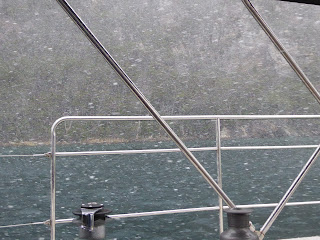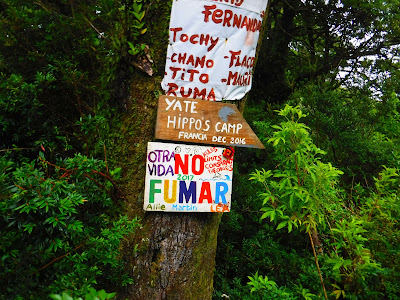 |
| Estero Fouque |
 |
| Seno Pia, Western Arm |
My mind drifts back to trade wind sailing in the tropics
last year. The wind blew from the North
East at 15-25kts, 28C during the day and 22C at night, and passages were
planned and plans followed with rare exceptions. On reaching our destination we´d
drop the anchor, put up the hammocks, and enjoy a celebratory drink on deck.
Sailing in southern Patagonia is different.
 |
| Horizontal snow, 46kt wind, safe anchorage |
From Puerto Williams, where Otra Vida has been based for the
last five months, most destinations of interest are to the west. The prevailing winds are NW-W-SW, 15-45kts in
strength, southern ocean low pressure systems carrying snow, sleet or
rain. Heading west means making a dash
between safe anchorages on those occasional days without much wind. Days with
winds from the east, while not unknown, are rare. Sailing back to Puerto
Williams is somewhat easier, but one quickly learns that easier is relative in
southern Patagonia.
No, the weather is not the reason to be down here. Everything else is.
 |
| Perfect reflection in Estero Coloane |
The scenery … well, I´ll be frugal with words and mostly let
the pictures carry their own descriptive load.
We don’t have a thesaurus on board Otra Vida. If we did, it would have been well thumbed by
now, searching for new superlatives each day to describe the experiences of
southern Patagonia. After a few days on
board it seems everyone ends up saying “Wow!”, “Oh my!”, “Holy shit!” or some
other fairly meaningless exclamation.
Words simply aren´t up to the task of processing what our eyes are
seeing.
 |
| Lovely still anchorage in Seno Pia, ice from the glacier floating past outside |
When the sun shines and the sky is blue these places are
magical on a level that is qualitatively different to the tropics. The feeling of space and peace is huge, elemental,
humbling. Southern Patagonia remains
almost untouched*, nature in a near pristine state, and you encounter
situations that are difficult to fit into any normal definition of sailing or
travel. The experience can be transformative,
sometimes other-worldly.
 |
| The same anchorage, rather more challenging conditions |
Then there are the sailors you meet. I first heard of the Micalvi Yacht Club, legendary
bolthole for every sailboat down here, from an experienced Antarctic sailor almost
a decade ago, and I was hooked. He summed
it up: “No one arrives there by chance, and everyone is interesting”. It´s certainly high on the list of contenders
for Best Yachtie Hangout in the World.
 |
| Evening beach fire, Caleta Olla |
 |
| Seno Pia |
However, there´s complexity in my feelings about
Patagonia. It is a place of genuine
danger – not glamourised danger, like extreme sports, but tangible real danger
of loss of boat and loss of life. Cold,
hard, wet, uncomfortable danger. This is
not hyperbole. These situations are not
theoretical. In 2017 already there has
been one occasion where loss of life for a person ashore was a probable outcome
(that the person is alive today is a testament to the professionalism and air rescue
equipment of the Chilean Armada), and three occasions where boat loss was a real
possibility, one of which resulted in damage to the hull below water line. To put this in context, in 40,000 miles of
sailing over the last eight years, including five major ocean passages and well
over a thousand nights at anchor, I cannot recall any situation where I felt even
a slight risk of losing my boat.
 |
| The view skiing down, Otra Vida just visible to the left in the distance |
And this sharp awareness of the contingent nature of life
here is mixed with sublime appreciation for the inescapable beauty of Patagonia
explored with a sailboat. The glaciers, the
hikes, the tranquil anchorages. Evening beach fires with driftwood. Whales, dolphins, sea lions, sea otters,
guanacos. Condors wheeling high above in
an azure sky. Hiking to a rock for
chilly sunset beers overlooking glacial lakes, crenelated mountains, perfect
fjords, sandy shorelines, windswept trees, spindly waterfalls. Occasional solo hikes and dinghy trips,
too. These form a treasure trove of
moments that I will carry with me forever, emotions so intense that tears
easily rise up in my eyes. These are
times you don´t forget, ever.
 |
| Guanaco |
There are many amazing places on this beautiful planet of
ours. I´ve been fortunate to experience
some of them, and for sure there are many more still to experience. But in quiet moments of late I´ve found
myself asking a question over and over again, a question without an answer, a
question that seems increasingly rhetorical: Where does one go after here?
 |
| Estero Fouque |
Many thanks to Bodo Will for some of these photos.












